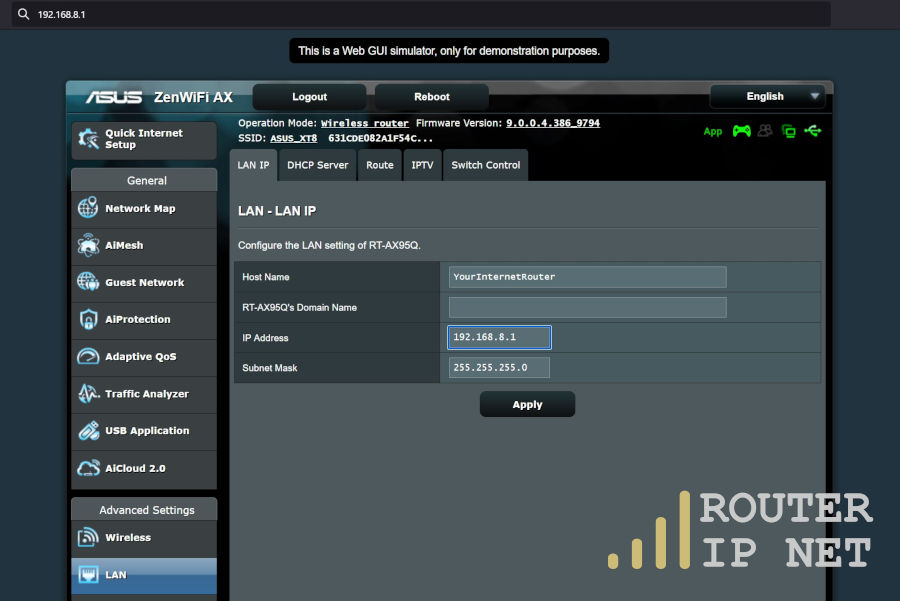192.168.8.1 - Admin Login
What is the 192.168.8.1 IP
192.168.8.1 is your private IP. Each device you connect to the wireless network gets a personal private IP related to the router’s one. For example, if you connect your smartphone first, it will receive the 192.168.8.2 private IP. The laptop you log onto the network next gets 192.168.8.3. Finally, the router will assign 192.168.8.4 to the third device you use to connect to the internet and so on.
In addition to being the foundation of your home or office network, the 192.168.8.1 IP allows you access to your router’s settings. From there, you can enhance your network’s security and make it run even smoother. In theory, your ISP should have tuned up the network so that you can get the most out of its capabilities. There can potentially be a few things you can do to improve your browsing experience in practice. Don’t worry. Accessing your router at 192.168.8.1 isn’t a complicated matter. You don’t need specific technical skills and know-how. The best part is that you can always roll back any changes made to the settings, even if you mistake.
Login at 192.168.8.1
Access your router as Admin
How to Login to your router with IP address 192.168.8.1
There are a few simple steps to follow to access your router’s admin panel at 192.168.8.1 .
Step 1: Connect to the network
Make sure your 192.168.8.1 is turned on, and the Wi-Fi is working. You should be able to connect to the wireless network with a device of your choice. Even though you will not have a problem adjusting your router’s settings using your phone, it is best to use a PC or a laptop. There are two reasons:
- The admin panel will most likely be optimized for desktop users, making the navigation from a mobile device a tad more tedious.
- You can connect the computer directly to the router using an Ethernet cable. The cable offers a more stable connection and reduces the chance of interruptions.
Step 2: Access the Admin Main Screen
Now that you have established a stable connection between your device and router, open an internet browser of your choice. All popular browsers like Mozilla, Chrome, and MS Edge should do the trick. Go to the address bar and type 192.168.8.1. Once you hit enter, you should see a prompt to enter a username and password. If the page doesn’t load, there is a problem with the connection. Check if you are connected to the 192.168.8.1 router’s network. Connect your computer to the router using an Ethernet cable if you haven’t tried it yet.
Step 3: Log in
Enter the username and password for your router and hit enter. You can find the default logins your router’s manufacturer has set up on the label at the back of the device. Check the user manual or the company’s website that made your 192.168.8.1 router if you can’t find the default username and password on the device.
What is the difference between 192.168.8.1 and Public IPs?
Your wireless router at home or the office operates with a set of two IP (Internet Protocol) addresses:
- Public IP
- Private (internal) IP
The device uses the public IP to communicate with other networks, like the internet. When you want to access a website or a service on the internet, you send the request from your public IP. At the same time, the website or service sends the data packages you request to the same address. The router uses the private IP to communicate with your home or office network devices. These devices can be:
- Personal computers and laptops
- Smartphones
- Tablets
- Printers
Who Decides What Your Private and Public IPs Are?
Your Internet Service Provider (ISP) is in charge of your public IP. There are billions of combinations that ISPs have in stock. However, each provider has access to a limited number of IPs depending on the scope of their operation. Because of this, they distribute the addresses on a first-come-first-serve basis. The technology is called “dynamic IP.” In theory, you can have a different public IP from your ISP’s list each time you connect to the internet. However, websites, some services, and servers require a stable, continuous connection to the internet. Changing their public IPs all the time disrupts their operation. Because of this, they can get a “static” public IP, which is reserved solely for their use. The case with your private IP at 192.168.8.1 is a little different.
The manufacturer of your wireless router decides what the default private IP of the device is. The 192.168.8.1 IP isn’t unique to just one brand or model. Some of the most popular router manufacturers use it, like:
- TPlink
- Samsung
- NEC
- Huawei
Except for certain ranges reserved by the Internet Assigned Number Authority (IANA), you can change your private IP to whatever you like. However, if you choose a number you are not authorized to use, the router’s settings platform will not allow you to save the changes. Remember that you need to use the same format as 192.168.8.1. That means you will have to use a string of four numbers between 0 and 255.
Can’t Log In
There are a couple of instances in which you will not be able to log in at 192.168.8.1:
- Even though you are connected to the right wireless network (or using an Ethernet cable), the login screen doesn’t load.
- The default username and password don’t work.
In both cases, likely, someone has already tinkered with the router’s settings. To be on the safe side, you might want to check if your router’s default private IP is 192.168.8.1. But, again, you may have to use different methods depending on the operating system you are using.
Find Your Local IP on Windows
Click on the Windows Start button at the lower-left corner of your screen. Next, search for the Command Prompt; when you open the console, type “ipconfig” and hit Enter. Several lines will load on the screen. Your current local IP is listed next to IPv4. Check if it says 192.168.8.1.
Find Your Local IP on Mac
Go to the top left corner of your screen and click on the Apple icon. Open the System Preferences menu and go to the Network tab. The next choice depends on the type of connection you are using at the moment. Choose Ethernet if you have connected your computer to the router via a cable. Choose Wi-Fi in case you are using a wireless connection. To the right of the window, you will see the information about your network. It should look like this:
- “Type of Network” (Ethernet/Wi-Fi) is connected to the “Name of the network” and has the IP address “your local IP address.”
If 192.168.8.1 is your local IP, you should be able to reach the login screen for the router’s settings. If it says something else, use the different local IP to go to the router’s settings and try the default username and password.
Find Your Local IP on Android
Open the Settings app and go to Network & Internet. Make sure you are connected to the Wi-Fi and are not using mobile data. Find the gear icon in the upper right corner of the screen after tapping on Wi-Fi. Scroll to the bottom of the next screen and find the Advanced tab. Tap on it, scroll a little more and find if the IPv4 address listed is 192.168.8.1.
The Username and Password Don’t Work
If you have had your Internet Service Provider set up your wireless network, or you have bought the device secondhand, either the ISP or the previous owner may have changed the default logins for your 192.168.8.1 router. Turn to them to ask what the valid login credentials are since you will not be able to use the ones on the label of the device. In case you can’t do that, don’t worry. You will still be able to get access to the device’s settings. The only hiccup is you will have to carry out a factory reset. The process isn’t hard, but it will roll back any changes in the setup you, or someone else, has previously made. If you have to use that last resort, here is how you carry out a factory reset on your 192.168.8.1 router:
- Make sure the device is plugged in and switched on.
- Locate the Reset button at the back.
- Press and hold the reset button. Depending on the model of the router, you might have to use a pin. Hold for at least 15 seconds until the lights on the front of the router start blinking.
- Release the Reset button and wait for a minute until the router boots up again.
You should have completed the factory reset of your router by that point. Next, open a browser and go to 192.168.8.1. Enter the default username and password and log in to your device’s settings.
Tune Up Your Network
You will find yourself in a menu that offers a variety of settings to play with. Some of the tabs and fields may have names that sound technical. However, the most important things to look for will be the Network and Wi-Fi settings sections.
To improve the way your wireless network works and protect it from unauthorized access, change the following things from the 192.168.8.1 menu:
- You have used the default username and password to log in to the network. Because manufacturers assign the same logins and private IPs to all devices they produce, your router’s network becomes vulnerable to attacks. Assign a new username and password to protect it.
-
For the same reason, you might want to change your private IP from
192.168.8.1 to something else.

- SSID – that is the name of your wireless network. The default name would be the make and model of your router, which may help hackers gain access to your device. Update it to something that makes your network stand out.
- The Wi-Fi password. Prevent people from gaining unauthorized access to your internet connection by password-protecting it.
Remember (or write down) any changes you make to don’t lock yourself out from your device and wireless network. Also, don’t forget to save any changes to make to your 192.168.8.1 router’s settings.
